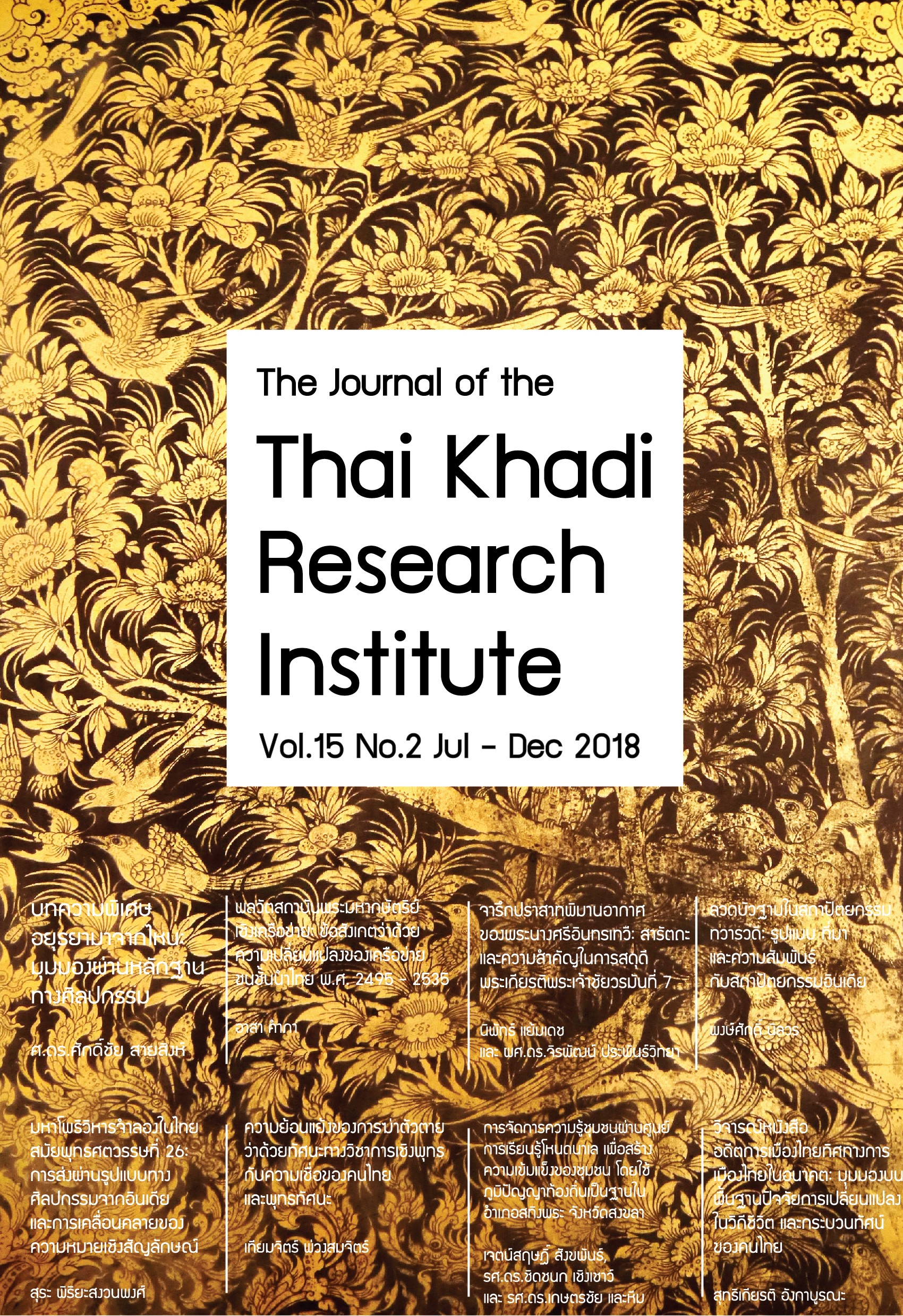มหาโพธิวิหารจำลองในไทยสมัยพุทธศตวรรษที่ 26: การส่งผ่านรูปแบบทางศิลปกรรมจากอินเดีย และการเคลื่อนคลายของความหมายเชิงสัญลักษณ์
Main Article Content
บทคัดย่อ
บทความวิจัยฉบับนี้ มีวัตถุประสงค์เพื่อวิเคราะห์รูปแบบทางศิลปกรรมและเหตุผลในการสร้างมหาโพธิวิหารจำลองในไทยสมัยพุทธศตวรรษที่ 26 รวมถึงคติหรือความหมายเชิงสัญลักษณ์ โดยใช้ระเบียบวิธีวิจัยทางประวัติศาสตร์ศิลปะ งานวิจัยนี้ได้วิเคราะห์เปรียบเทียบกับมหาโพธิวิหารองค์ต้นแบบที่เมืองพุทธคยา ประเทศอินเดีย และมหาโพธิวิหารจำลองที่สร้างขึ้นในภูมิภาคเอเชียตะวันออกเฉียงใต้ในช่วงก่อน พุทธศตวรรษที่ 26 ได้แก่ ล้านนา พุกาม และหงสาวดี
ผลการศึกษาพบว่า ในประเด็นด้านรูปแบบศิลปกรรมนั้น มหาโพธิวิหารที่จำลองในช่วงพุทธศตวรรษที่ 26 ไม่พบแห่งใดที่ยังคงจำลองระบบแผนผังสัตตมหาสถานแล้ว อีกทั้งหลายแห่งยังละเลยการมีต้นพระศรีมหาโพธิ์ซึ่งเป็นสัญลักษณ์สำคัญอันเกี่ยวเนื่องกับนาม “มหาโพธิวิหาร” และยังพบว่าหลายแห่งจำลองขึ้นโดยเชื่อมโยงเข้ากับปูชนียสถานอีกกลุ่ม คือ กลุ่มสังเวชนียสถานทั้ง 4 ซึ่งไม่พบในกรณีการจำลองมหาโพธิวิหารก่อนพุทธศตวรรษที่ 26 ส่วนหน้าที่ใช้สอยพบว่ามีหลากหลายมาก เช่น เป็นวิหาร อุโบสถ พิพิธภัณฑ์ โรงเรียนศึกษาธรรมะ เป็นต้น
นอกจากนี้ มหาโพธิวิหารจำลองที่สร้างขึ้นในพุทธศตวรรษที่ 26 สามารถอ้างอิงรูปแบบโดยตรงจากอินเดีย ไม่จำเป็นต้องอาศัยองค์ความรู้จากการจำลองมหาโพธิวิหารที่มีขึ้นในยุคสมัยก่อนหน้า ความแพร่หลายของการจำลองที่มีขึ้นยังแสดงให้เห็นถึงการ “หวนสู่อินเดีย” หรือหันกลับไปให้ความสำคัญกับอินเดียในฐานะแหล่งอ้างอิงความศักดิ์สิทธิ์ในโลกพุทธศาสนา ซึ่งไทยหรือสยามในอดีตเคยอ้างอิงลังกาในฐานะดังกล่าว
Downloads
Article Details
ผู้เขียนจะต้องลงนามในแบบฟอร์มรับรองบทความ เพื่อให้คำยืนยันความรับผิดชอบว่า บทความของผู้เขียนนั้นไม่เคยตีพิมพ์ที่ใดมาก่อน พร้อมรับทราบว่า กระบวนการส่งบทความเข้าพิจารณาและตีพิมพ์ในวารสารไทยคดีศึกษานั้น จะไม่มีการเรียกเก็บค่าใช้จ่ายในการดำเนินการ ยกเว้น ในกรณีที่ผู้เขียนขอยกเลิกการตีพิมพ์บทความในวารสารไทยคดีศึกษาไม่ว่าด้วยสาเหตุใด และหลังจากบทความนั้นเข้าสู่กระบวนการพิจารณาของผู้ทรงคุณวุฒิไปแล้ว ผู้เขียนจะต้องรับผิดชอบต่อค่าใช้จ่ายที่เกิดขึ้นในกระบวนการประเมินเป็นจำนวนเงิน 3,000 บาท (สามพันบาทถ้วน)
เอกสารอ้างอิง
Ansari Abdul Q. (1990). Archaeological Remain of Bodhgaya. Delhi: Ramanand Vidya Bhawan.
Benjamin, Rowland Jr. (2016, March 5). Collections in Boston Museum. Retrieved April 2, 2018, from http://www.mfa.org/collections/object/model-of-the-mahabodhi- temple-20142.
Cunningham, A., Sir. (n.d.). Mahabodhi, or, The great buddhist temple under the Bodhi tree at Buddha - Gaya. Varanasi: Indological Book House.
Fine Arts Department. (1999). Prachum phongsāwadān chabap kānčhanāphisēk lem 3 [Thai Golden Jubilee Chronicles Volume 3]. Bangkok: Office of Literature and History.
Griswold, A.B. [Ditsakun, S., Prince (Tran. & ed.)]. (1986). Mahā phōthi wihān thī Phutkhayā læ kān čhamlō̜ng bǣp [Mahabodhi Temple in Bodhgaya and imitation]. Silpakorn University Journal, (Last semester), 20 - 46.
"Mahāparinipphānsūt" Phra traipidok lem thī sip phra suttantapidok lem thī sō̜ng, thīkhanikāi mahāwak [“Death of Buddha Literature” Phratraipidok Vol. 10, Phrasuttantapidok Vol. 2, Thikhanikai mahawak]. (1982). Bangkok: Department of Religious Affairs.
Ongsakul, S. (1993). Wat čhet yō̜t nai thāna ʻāyu mư̄ang Chīang Mai [Wat Chet Yot in Chiang Mai Astralogy]. Ancient city journal, 19(2), 138 - 147.
Paramanuchitchinorot. (2011). Pathomsomphōthikathā [Life of Buddha]. Bangkok: Banlưtham.
Ryojun, S. (2016). The Mahabodhi Temple at Bodh Gaya. Delhi: MLBD.
Thamrungraeng, R. (2013). Čhēdīyasathān klum Sorot mahā sathān khō̜ng sī Langkā nai samut phāp traiphūm Thai samai ʻAyutthayā thưngrattanakōsin tō̜n ton [Sixteen Great Lanka Pagodas in Ayuthaya and early Bangkok’s buddhist cosmology illustration]. Khwāmkhit khwāmmāi khwām chư̄a khō̜ng kān čhārik yong sathānthī saksit [Thought, meaning and believe of Holy sites pilgrimage] (97 - 100). Bangkok: Faculty of Archaeology, Silpakorn University.
Tingsanchali, C. (2012). Sattamhāsathān: phut prawat tō̜n sawœ̄i wimutsuk kap sinlapakam ʻIndīa læ ʻĒchīa ʻākhanē [Sacred sites related to seven weeks after Buddha’s enlightenment in India and Southeast asia’s arts]. Bangkok: Muangboran.
_____. (2013). Sangwētchanīyasathān læ sathānthī samkhan thāng phut prawat nai ʻIndīa - nēpān [Four sacred sites and Buddha life’s important places in India and Nepal]. Nonthaburi: Museum Press.
Wat Pa Siriwattanawisuth. (2016). Wat pā siri watthana wisut [Wat Pa Siriwattanawisuth]. Retrieved April 2, 2018, from http://www.intaram.org/index.php?lay=show&ac=article &Id=538979570&Ntype=22.


